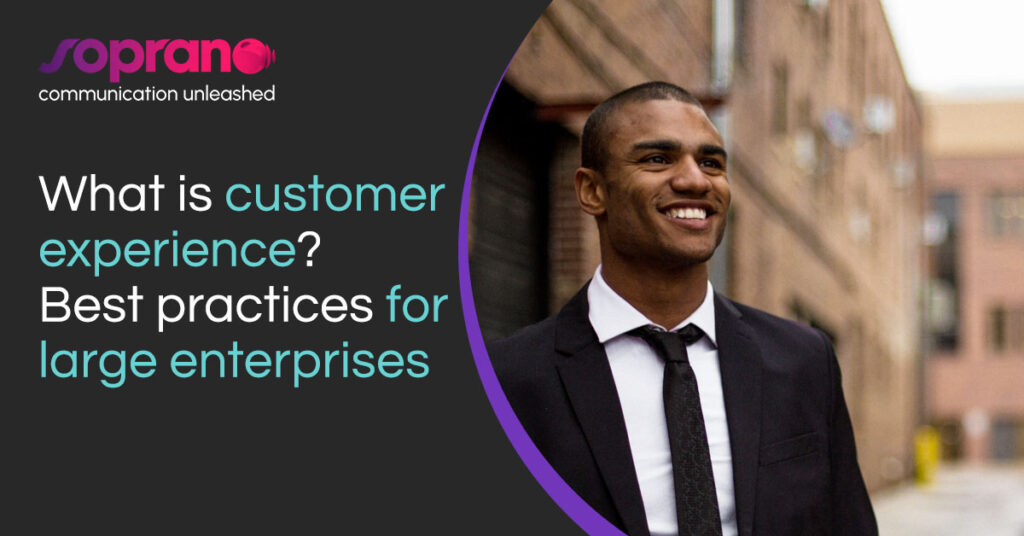
Think about two brands that you like so much that you usually recommend them to your friends. Undoubtedly, they have things in common. Maybe, it’s their real-time customer support, their easy and intuitive buying process, or products/services that always meet your expectations. Well, what they have in common is a good Customer Experience.
Nowadays, improving Customer Experience has become one of the main objectives of large enterprises. Why? Because it is one of the most effective ways to gain customers’ loyalty.
Those loyal customers will be the ones who will rebuy your product, promote your brand to others, and help you make a difference.
Improving Your Omnichannel Customer Journey With Mobile Messaging
Many people think CX is just about having a good product/service and sending their customers email promotions. But it goes much further than that.
What is Customer Experience?
Customer Experience is every interaction customers have with a business during the buying journey. Every step that a customer takes in the buying process – research, shop, communicate – will create a brand perception.
The customer experience is not only about actions; it is also the emotions that a brand makes people feel when they buy a product/service.
If their experience is good, they are likely to buy again and recommend the brand to others. Those loyal customers will become a cornerstone of sales and marketing strategy.
On the contrary, if the experience is not good enough, they may choose another company next time. If it is terrible, it may have the opposite effect: they would recommend not to choose it.
Benefits of a Great Customer Experience
– Increase customer satisfaction.
– Increase sales through word of mouth and positive reviews.
– Improve brand advocacy.
– Reduce costs in other areas of the business
Zendesk
52% of customers say they make a special effort to shop for brands they are loyal to.
¿What causes a bad customer experience?
– Lack of information at the time of purchase.
– Poor communication.
– Eternal waiting times.
– Untrained employees.
– Unpersonal service.
50% of customers will switch to a competitor after one bad experience.
Zendesk

Example of a bad customer experience
Customer experience is essential in every business, regardless of size, industry, and location.
Imagine you want to buy your child a pair of sneakers as a birthday present. Since the website doesn’t make delivery dates clear, you try to contact someone who can confirm when the shoes will arrive.
There is no virtual chat on the website, only a contact phone number. You call customer service, and they tell you that deliveries take between 5 and 10 days. Your child’s birthday is in 15 days, so you make the purchase.
When the gift arrives at your house ten days later, you notice they brought you the wrong size. You call customer service about five times and when they answer, they tell you that the exchange will take another ten days.
You explain that it is your child’s birthday in 5 days and that you need them sooner. Finally, you have to improvise another gift, and ten days later, the sneakers arrive. Your son loves them, but probably you won’t buy from that company again and much less recommend it.
Reasons for a bad CX
- The website did not have enough information for the customer to make the purchase.
- There was no real-time customer service. The customer is the one who had to make the call.
- The product didn’t meet expectations.
- Difficult communication and slight predisposition to solve the problem.
Example of a good customer experience
Now let’s think about the opposite situation. You want to buy your child a pair of sneakers as a birthday present.
The website is easy to use, has authentic images of the products, and gives you all the information you need. Via chat, an assistant asks you if you need help with anything.
In less than 15 minutes, you make the purchase. You automatically receive an email with all the details and the bill. It says that the order will arrive between 5 and 10 days.
Five days later, you receive another email telling you that your order will arrive the next day. On the date indicated, you receive an SMS with a link where you can see the delivery route.
The package arrives on time and without any problems. Your child doesn’t like the sneakers very much and wants to change them. The email they sent you said that there were two ways of contact in case of eventualities: reply to the email or write via WhatsApp.
You write via WhatsApp explaining that you want to make a change. You have a real-time conversation with Customer Service in which they tell you what to do to make the change. After the same process, you receive the new sneakers within five days.
Now your child is happy, and you will probably choose that store again when you need other sneakers.
Reasons for a good customer experience
- The website had all the information the customer needed.
- The website offered real-time support.
- The customer could choose the channel of preference to communicate with the brand.
- The customer received information during all the process.
- The order arrived on time.
63% of consumers reported that they are more likely to return to a real-time support website.
Emarketer

Customer Experience Best Practices
Understand the entire buyer journey
The buyer’s journey is the entire process the buyers go through from the time they realize that they want to buy something until they actually buy it. Being aware of the entire buyer journey helps companies understand and improve every touchpoint with buyers.
Measure your Customer Experience
Consumer needs and demands change all the time. Businesses must keep Customer Experience constantly updated to gain customers’ trust and confidence.
Some metrics and tools allow brands to know if the CX is good, fair, or bad. Measuring the results is fundamental to making changes and improving CX.
According to Gartner, the most traditional metric for measuring Customer Experience is Customer Satisfaction. Businesses can measure CSAT through product reviews rankings, shopping scores, or survey questions.
Surveys can provide very accurate metrics on Customer Experience. Nowadays, there are many ways to send surveys to customers without hassle. For example, you can send them a text message with an external link or an email with some quick questions.
The most important is to always send the right message at the right time and through the right channel.
Build an omnichannel experience
An omnichannel CX means delivering an integrated experience where customers can enjoy and pick up where they left off with the same standard of experience regardless of the device, platform, or communication channel employed.
Instead of managing each channel separately, an omnichannel customer experience incorporates a combination of knowledge acquired through existing channels such as CRM, helpdesk, analytics, and customer insights.
Most large organizations with revenue of more than $1 billion have more than 50 CX metrics
Gartner
Integrate communication technology
Communication technology is replacing human interaction in CX. By using the right tools, large enterprises can automate processes, save time, and increase sales without losing the emotional experience delivered by humans nowadays.
Thanks to automation, customers can have more accurate information and better options to make decisions easier.
